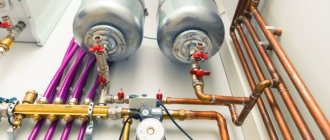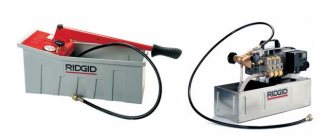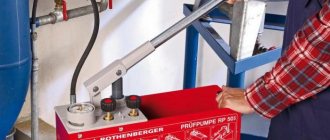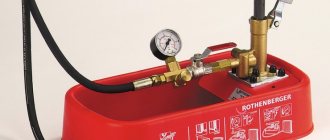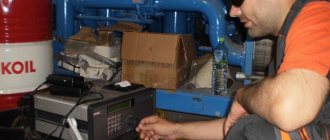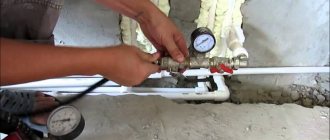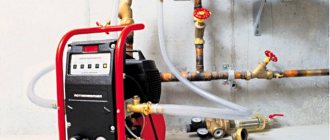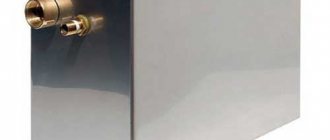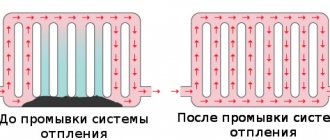Hydraulic testing of heating system pipelines is mandatory when:
- Preparatory work for the new season.
- Installation of boilers and pipes.
- Replacement of individual sections.
The main purpose of the tests is to identify leaks and a number of local damage, connections without the proper level of tightness, as well as other problems due to which the functionality of the heating pipeline is lost during further operation.
Pressure testing of heating systems is the process of testing heating equipment and pipelines with test high pressure. The purpose of testing is to check: the strength of the housings and walls of the entire circuit (pipes, radiators, fittings, etc.); tightness of connections of all elements of the system; operability of taps, pressure gauges, valves and gate valves.
If we are talking about apartment buildings, then testing becomes the responsibility of housing and communal services employees. In private houses, the owners themselves become the organizers of the process, but here everything needs to be done either yourself, or you should turn to specialists with the appropriate skills.
Pneumatic heating test
Pneumatic heating test
In some cases, it is impossible to meet the basic conditions for carrying out a hydraulic test of a heating system. A similar situation may arise after repair work is carried out in winter, when the ambient temperature is below +5°C. Then you should draw up a pneumatic test report for the heating system.
Its essence is to create a pressure of 100 kPa in the heating lines. Moreover, within 10 minutes the level of its decrease should not exceed 10 kPa. To check this, you should use pressure gauges with an accuracy class of 2.5 and a division value of no more than 5 kPa. All characteristics of the equipment may be present in the pneumatic test report of the heating system.
It is not recommended to carry out such checks for polymer pipelines. However, the standards allow testing of air heating systems made of polypropylene or metal-plastic in the following cases:
- Technical conditions do not allow filling with liquid. Most often this is due to the use of antifreeze;
- Ambient temperature below 0;
- Temporarily there is no coolant in the required volume.
The main problem when testing a system by air is finding places where tightness is lost. If a sharp decrease in pressure was noticed during the procedure, it is recommended to perform a zonal check of the areas. This is the only way to determine the location of a possible leak. Therefore, they prefer the hydraulic method as it is more convenient.
Upon completion, a pneumatic test report of the heating system is drawn up, in which the results are entered.
How to deal with pressure changes
Features of central heating systems
It should be correctly understood that in heating mains running from boiler houses or thermal power plants to consumers, the level of pressure and temperature of the coolant differs significantly from what is supplied to apartments. Naturally, it must be reduced to safe values that meet the standards.
The intra-house coolant temperature and pressure in the heating system circuits are adjusted by adjusting the elevator unit, which is most often located in the basement of a multi-story building. In this design, hot water supplied to the heating circuit from the main is mixed with cooled return coolant.
The design of the elevator unit includes a so-called mixing chamber, equipped with a nozzle, the size of which regulates the flow of hot water into the house heating system. Since the coolant coming from the central pipeline has a very high temperature, before entering the heating circuit of the house, it is mixed with the cooled “return” water.
The mixing chamber of the elevator unit is designed approximately as shown in this diagram
The illustration above shows the main working part of the elevator assembly with a mixing chamber and nozzle. In the diagram below, the location of this element is highlighted with a yellow ellipse.
Diagram of an elevator unit that ensures that the pressure and temperature of the coolant are brought to the established standards
1 — main line for the central supply of hot coolant.
2 - return pipe of the central main.
3 - valves that disconnect the intra-house system from the central heating main.
4 - flange connections.
5 - mud filters, to prevent clogging of the pipes of the intra-house system with insoluble impurities or debris, which are difficult to completely get rid of in central lines.
6 - pressure gauges for constant monitoring of pressure in different parts of the system. Please note that pressure gauges are installed both on the main pipes, that is, before and after the elevator unit. It is the latter that controls the pressure level in the intra-house system.
7 - thermometers, also showing the temperature in different parts of the general system: tc - in the central line, at the inlet, tc - in the supply pipe of the intra-house heating system, toc and toc - in the return of the system and the central line, respectively.
8 - the main working unit, that is, the elevator itself.
9 - jumper pipe, which ensures the supply of cooled coolant from the return to the mixing chamber of the elevator unit.
10 - valves that make it possible to disconnect the intra-house wiring of the heating system from the elevator unit. This is necessary, for example, to carry out certain preventive or repair work.
11 - supply pipe for intra-house wiring, into which coolant is supplied at the required temperature and under the pressure established by the standards.
12 - return pipe for intra-house wiring.
It is clear that the diagram is given with significant simplification, simply to demonstrate the principle of operation of the elevator. In fact, this elevator unit looks much more complicated, and only heating network specialists can understand its design.
Without special knowledge, it is simply impossible to understand this “intricacy” of the pipes of the heating station of an apartment building with an elevator unit. But residents have no business meddling here - this is the lot of heating supply specialists.
Only heating system specialists should monitor the stable operation of elevator equipment. They monitor pressure and temperature indicators, conduct technical inspections, carry out preventive measures and, if devices fail, replace them with serviceable ones. Thus, most problems with insufficient or excess pressure in the intra-house system can be solved by properly adjusting the elevator unit and monitoring its operation.
The combination of simplicity of the operating principle and reliability - the elevator unit of the heating system
Despite the introduction of innovative control systems, there is no hurry to abandon the use of elevator units that are simple in their operating principle. And this is unlikely to happen in the near future. To learn more about how the elevator unit of the heating system , what devices it consists of, how it is calculated and maintained - read about all this in a special publication on our portal.
However, some nuances may depend on the apartment owners.
- For example, standard pipeline risers have a nominal diameter of 25÷33 mm. The pipes of the heating circuit of the apartment should have the same diameter. If there is a need to replace a certain section of the pipeline, then the new pipe inserted in place of the damaged section should have the same diameter as the removed one - not narrower and not wider.
- It is necessary to regularly carefully inspect the heating circuit of the apartment, especially carefully checking the connections of pipes and radiators.
- It is periodically necessary to bleed air from radiators. This is especially true for apartments located on the top floor of the building. Modern batteries go on sale already equipped with special valves, so servicing the devices is not difficult. If not, you will have to install Mayevsky taps or automatic air vents on the batteries.
The pressure reducer will protect the intra-apartment wiring from the negative consequences of pressure surges in the heating system
- To ensure that the heating circuit of the apartment does not suffer from water hammer, which, unfortunately, is not excluded during test runs of the central system before the heating season, a special device is cut into the pipe supplying coolant to the apartment at the beginning of the circuit - a pressure reducer. It prevents the negative impact of sudden pressure surges on radiators and pipe connections.
Pressure in the autonomous heating system of a private house
Most often, the heating system of a private house involves the presence of a boiler equipped with a heat exchanger. This element is probably the weakest link in terms of pressure. Most heat exchangers are designed for pressure loads exceeding 5, maximum 7 atmospheres.
Due to the fact that the maximum permissible pressure of the heating circuit is determined by the element most unstable to it, which is the heat exchanger, this value is the determining standard for autonomous heating. Therefore, when purchasing a heating unit, you need to pay special attention to what pressure it is designed for. But there is no “tragedy” in this - as a rule, for a one-story house or autonomous heating in an apartment, an indicator of 2–3 atmospheres (0.2–0.3 MPa or 20–30 meters of water column) is quite sufficient.
Scheme of an autonomous heating system with an open expansion tank.
If an open expansion tank is provided in the autonomous heating system, then there is no need to worry about the fact that pressure dangerous to the integrity of pipes and radiators may arise. The only thing that should not be forgotten is that after installing such a design, you must carefully ensure that there is a sufficient amount of coolant in the system, since it tends to evaporate.
If an open expansion tank is installed in the heating circuit, the pressure will never be higher than the static maximum. This ensures the safety of the heating system elements, but is not always effective in heating the house, precisely because the pressure is too low. The explanation is simple - the coolant, slowly moving through the channels of the circuit and overcoming hydraulic resistance, quite quickly loses its thermal potential, and approaching the “return” in the boiler room, it becomes almost cold. Therefore, the boiler has to work almost continuously, maintaining the set temperature. In this regard, fuel will be consumed uneconomically, and you will have to pay considerable sums for it.
Nowadays, there is a steady tendency to abandon such solutions in favor of systems with forced circulation and a membrane expansion tank. Moreover, specialized stores offer a very wide selection of circulation pumps with different ratings for performance and pressure generated.
Autonomous heating safety group, which includes a pressure gauge, safety valve and automatic air vent
If a closed heating system is installed with a pump installed in it and a sealed membrane expansion tank, then in order to constantly monitor the current parameters, a pressure gauge is installed on the coolant supply pipe. In addition to this, this so-called “safety group” includes elements such as an automatic or manual air vent and a safety valve that will operate if the pressure in the system exceeds the permissible threshold.
Autonomous heating in an apartment in a multi-storey building
In recent years, more and more residents of apartments in multi-storey buildings are deciding to acquire an autonomous heating system, since, despite the high cost of equipment and problems with legalization, the return on all costs is quite high.
The main advantages of autonomous heating of an apartment is that payment for heat will have to be made only in the winter, and only based on the energy consumed. In addition, it becomes possible to turn on the heating in the off-season, when the central system is not yet functioning or is already turned off.
Basic devices that ensure the functionality and safety of an autonomous heating system
However, when installing autonomous heating in an apartment, you need to remember that monitoring its serviceability and safe operation, including adjusting pressure and temperature, falls on the homeowner. In this regard, its installation and initial start-up should not be done independently - this process must be carried out by specialists who have special permission to work with gas equipment.
The main elements and units of an autonomous heating system are most often installed in the kitchen, since all communications necessary for its arrangement, such as gas and water, are connected to it.
In most cases, a boiler for an autonomous apartment heating system is installed in the kitchen - there is probably no better place for it.
Now we need to consider the question of what could cause instability of pressure in the autonomous heating system of an apartment.
- Most often, the pressure in the system can be reduced due to a coolant leak, which can occur at pipe connections, at the radiator inlets or at the air vent. Therefore, if the pressure gauge shows a decrease in pressure in the system, it is necessary to immediately inspect the entire circuit, paying special attention to the connecting nodes. Any leak found must be repaired immediately. To do this, in some cases it is necessary to drain all the coolant from the system, and after repairs, fill it again.
An incorrectly selected or faulty membrane expansion tank may well cause unstable, high or low pressure in the heating system
- Damage to the expansion tank membrane - this can occur due to an initially incorrect calculation of this element of the heating system. The membrane may stretch, crack, or rupture completely. When choosing an expansion tank, you need to remember that its volume must correspond to the actual parameters of the heating system being created. It is clear that you want to install the most compact devices to save space, but fighting against the laws of physics is pointless.
The appendix to the article will provide a method for calculating the volume of an expansion tank for an autonomous heating system, with the attached calculator.
- Air locks in the system may occur in the first days after it is filled with new coolant. Therefore, at this time, heating usually shows slightly reduced parameters, since air must be completely released from the system. To avoid the formation of plugs, it is recommended to fill the system with low water pressure, that is, very slowly.
Many modern heating radiators are equipped with a Mayevsky tap by the manufacturer, as they say, “by default.”
To quickly get rid of air locks in the radiators, on each of them, it is necessary to install a Mayevsky tap, which is designed specifically for this purpose.
- If the pressure drops after replacing old batteries with aluminum radiators, then at first very active chemical reactions can occur inside them, during which gaseous substances are released. When this period has passed and free gases have been completely released through the air vents, the heating system will return to normal operation.
Aluminum heating radiators are “famous” for their active gas formation at the very beginning of operation. It's okay - after a short time this process should stop, and their work will return to normal.
- The pressure in the circuit may also decrease due to failure of the boiler heat exchanger (rupture or dense overgrowth with insoluble deposits - when using untreated water as a coolant. In this case, you cannot cope with the problem on your own, and you will have to call a specialist.
- The heating temperature of the coolant is set too high, when it is not too low outside. In this case, the water in the heating circuit may even boil.
- There is a blockage in one of the pipe sections or in the connecting nodes, which inhibits the normal circulation of the coolant. In this case, the pressure in the narrowed area drops, and in the area before the blockage it will be increased, as a result of which depressurization of the circuit may occur there.
- Narrowing of pipeline clearances is usually observed in old heating systems that have been in operation for decades, resulting in thick layers of scale and dirt forming on the pipe walls due to poor-quality coolant.
To talk about the balanced operation of the heating system if the circuit pipes are in this condition is simply naive!
Either cleaning, or replacing with new ones, followed by filling with high-quality coolant... A decrease in pressure due to this problem in an autonomous system occurs if the central heating system, which has been operating for a long time, has been replaced with an autonomous one, and the radiators and pipes of the circuit remain old . And in order to avoid such troubles when setting up an autonomous system, it is recommended to completely dismantle the old circuit and install a new pipeline and radiators in its place.
In addition, it is necessary to fill the closed circuit with a coolant, which can be water that has undergone the necessary preparation - mechanical filtration and softening, that is, the removal of hardness salts that cause build-ups on the walls of the pipes.
* * * * * * *
So, in order for any heating system to function well and show its efficiency, the pressure in it must be normal. If this parameter is underestimated, there is insufficient temperature in the premises of the apartment or house. As the pressure in the system increases, its most vulnerable elements may not be able to withstand it. Therefore, it is recommended to immediately bring all system parameters back to normal, and install a pressure gauge in the heating circuit in order to promptly respond to deviations from the norm, identify the causes and eliminate them. If the apartment is connected to a central heating system, the presence of control and measuring instruments will help motivate complaints to the management company about the low quality of services provided.
To understand in more detail the causes of pressure instability in autonomous heating systems, with methods for identifying them and methods for eliminating them, watch a very informative video on this topic:
Test pressure
According to SNIP 3-05-01-85, which was replaced in 2003, pressure testing must be carried out according to the rules. When carrying out work in apartment buildings, it is necessary to:
- The pressure was more than 1 mPa (that's 10 bar) - for hot water supply systems and heating circuits with heaters.
- At least 10 bar for panel and convector heating systems.
- At least 6 bar for circuits in which radiators made of stamped steel or cast iron are installed.
- The pressure for hot water supply must be greater than the working one and another 5 bar on top (but cannot exceed 10 bar).
If panel heating and heat exchangers are used, the pressure should not have a pressure greater than the maximum permissible for the devices. If you are testing air in a steam or panel heating system, you need to check the pipes that fit into the ventilation equipment. The air should have a pressure of 1 bar.
Hydrostatic method of testing pipelines
4.1. Upon completion of installation work, installation organizations must carry out:
testing heating systems, heat supply, internal cold and hot water supply and boiler rooms using the hydrostatic or manometric method with drawing up a report in accordance with mandatory Appendix 3, as well as flushing systems in accordance with the requirements of clause 3.10 of these rules;
testing of internal sewerage and drainage systems with drawing up a report in accordance with mandatory Appendix 4;
individual tests of installed equipment with drawing up a report in accordance with mandatory Appendix 1;
thermal testing of heating systems for uniform heating of heating devices.
Testing of systems using plastic pipelines should be carried out in compliance with the requirements of CH 478-80.
Tests must be carried out before finishing work begins.
Pressure gauges used for testing must be calibrated in accordance with GOST 8.002-71.
4.2. During individual testing of equipment, the following work must be performed:
checking the compliance of the installed equipment and the work performed with the working documentation and the requirements of these rules;
testing equipment at idle and under load for 4 hours of continuous operation. At the same time, the balancing of wheels and rotors in pump and smoke exhauster assemblies, the quality of the stuffing box packing, the serviceability of starting devices, the degree of heating of the electric motor, and compliance with the requirements for assembly and installation of equipment specified in the technical documentation of the manufacturers are checked.
Heating system testing equipment
Most often, a pressure tester is used to perform a hydraulic test. It is connected to the circuit to regulate the pressure in the pipes.
A huge number of local heating networks in private buildings do not require high pressure, so a manual pressure tester will be sufficient. In other cases, it is better to use an electric pump.
Hand-held devices for testing heating systems develop a force of up to 60 bar or more. Moreover, this is enough to check the integrity of the system even in a five-story building.
The main advantages of hand pumps:
- Reasonable cost, which makes them accessible to many consumers;
- Light weight and dimensions of hand presses. Such devices are convenient to use not only for personal purposes, but also for professional use;
- Long service life without failures or breakdowns. The device is so simply designed that there is nothing to break in it;
- Suitable for medium and small heating equipment.
Branched and large circuits on large areas, multi-story buildings and production facilities are checked only with electrical devices. They are capable of pumping water under very high pressure, which is unattainable for manual devices. They are equipped with a self-priming pump.
Electric pumps develop a force of up to 500 bar. These units are usually built into the main line or connected to any opening. Basically, the hose is connected to a tap through which the pipe is filled with coolant.
Performing heating pressure testing is a very complex technological procedure. That’s why you shouldn’t do it yourself; it’s better to use the services of professional teams.
(2 votes, average: 5 out of 5)
Brief excerpts from regulatory documentation, rules and SNiP for heating pressure testing.
Analyzing the statistics of the questions you ask and understanding that many questions regarding pressure testing of the heating system for the majority of our audience remain incomprehensible to you, we decided to make a selection from the necessary points and Rules for pressure testing, approved by the Ministry of Fuel and Energy of the Russian Federation and SNiP.
All SNiPs and rules contain more than 100 pages of information, which are sometimes difficult to understand, so in order to make the task easier for you, so that you can look at and, if necessary, refer to the desired paragraph of a specific regulatory document, we have processed the applicable regulatory documents and in a brief form posted on the site. Explanations to the Rules and SNiP can be found in the article: “Norms and rules for performing pressure testing of a heating system”
Diagnostic methods
- Water testing is the main method by which all circuits are tested. In this case, water should be pumped into the lower part of the pipes through a tap. It is possible to pump liquid using both automatic and manual pressure testing pumps. The advantage of this method is that it is very simple to complete all the work, and the efficiency of leak detection is high. The fact is that traces of liquid will immediately appear on the pipes.
- Testing with air is not a very effective method, since it is quite difficult to detect leaks. But it is permissible to use this technique at subzero temperatures – the air will not freeze. A compressor is used to force air into the system. It is connected using an adapter to the pipeline. In order to find the leak, you need to listen. Once you find the approximate location of the leak, use a soap solution.
How does the crimping process work?
- Preparing the system before pressure testing. If the system is autonomous, then the heat generator is turned off first. If not, then taps are used to close off the area where inspection is required. The coolant must be drained.
- The system circuit is filled with water having a temperature of no higher than 45 C. The air is gradually released.
- The compressor is connected and air begins to flow into the pipes.
- At the beginning of the procedure, the pressure is brought to the working level and the area is visually inspected for violations. Then the pressure is gradually increased to the test level - this is maintained for at least 10 minutes.
- The area or the entire system is inspected for leaks at the connections. It is mandatory to visually inspect fittings, radiators and the entire length of pipe walls for fistulas. If deviations are detected, all defects and shifts are recorded. The operation of taps and valves is checked.
- Using pressure gauge readings, the drop in pressure level is determined. If it has not decreased, the system is in normal operating condition.
- Based on the results of the inspection, a report is drawn up.
What testing tool is needed?
Now let's talk about what crimping equipment is used during the work. To perform hydraulic tests, you need to use specially designed pumps (they are called pressure testers). You can find two modifications - electric and manual.
Hand pumps are a cuvette in the shape of a rectangle; water is poured into it, which is then pumped into the heating system. A plunger-type pump is placed on its side, with a handle on top of it. It is with its help that the pump plunger is driven. There are pressure gauges on the body, with their help the pressure of the liquid pumped into the system is controlled. One shut-off valve allows water to be shut off after pumping into the pipes is completed. The second valve allows liquid to be drained from the tank.
Plunger pumps operate on the same principle as simple piston pumps, which are used to inflate bicycle or car inner tubes. But there is also a difference - the plunger pump design has a cylindrical steel piston that moves in the housing with minimal clearance. It is with this that it is possible to pump liquid into the heating system at a pressure of up to 60 bar.
The main disadvantage of manual mechanisms is that it takes a long time to carry out crimping work. Moreover, the test time depends on the length of the heating circuits. Sometimes it takes several hours to completely fill. Imagine how much strength you will expend to pull the handle.
It is with the aim of reducing costs and automating the process that electric pumps are used by specialists. They work on the same principle as manual ones, only muscle power is replaced by an electric drive. Automatic systems are good because you can set the required level of discharge pressure. Once it is reached, all equipment is turned off.
Automatic devices can pump liquid at a pressure of 40-100 bar. But there are also industrial designs that are capable of creating pressure up to 1000 bar.
Please note that the Ministry of Energy sets requirements according to which it is necessary to use only spring-type pressure gauges for control; their accuracy class must be 1.5. The circumference of the body must be more than 160 mm
The scale must be designed to measure pressure, the value of which is at least 4/3 of the minimum, the division value is less than 0.1 bar.
Manometric and hydrostatic testing of pipelines
According to the requirements of SNiP, before starting the utility network, pressure tests of pipelines should be performed for leaks. Carrying out such a check allows you to identify in advance defective sections of the pipeline that can collapse if the operating pressure is exceeded. This significantly reduces the risk of emergency situations in the heating, plumbing or other engineering system.
Features of the technology
The procedure for testing pipes using the hydrostatic method is as follows:
- Pipeline structures are thoroughly cleaned and accumulated contaminants are removed from them. This is necessary to improve the accuracy of measurement results.
- Several pressure gauges independent of each other are connected to the water supply. The devices are used to determine the pressure in the circuit under test, as well as to determine leaks of the working medium.
- The system is filled with water, creating a pressure in the selected section of the pipeline that exceeds the operating norm by 20–25%.
- During the exposure time, specialists carefully monitor the readings of measuring instruments. If the pressure begins to drop, this is interpreted as a sign of insufficient tightness of the pipeline. If the pressure gauge readings remain unchanged during the holding time, this indicates the absence of leaks and the proper condition of the pipe.
- Based on the results of the hydraulic test, specialists draw up a report, which indicates the detected problems and provides recommendations for eliminating them. If necessary, defective sections of the heating or other mains are repaired or replaced.
Basic price of services for pressure testing (hydraulic testing) of pipelines of heating systems in St. Petersburg and Leningrad Region
| Services list | Unit | Price of services |
| Departure and work of a pressure testing team at the customer’s site using a hydrodynamic machine KO-514, KO-502b2 (pump capacity 170 l/min, pressure 0-160 atm, connecting fitting M39x2, at least 5 tons of tap water on board for filling into the system and testing , additional water from the customer or for an additional fee, reference monometer from the customer) | 1 unit | from 18,000 rub. |
| Departure and work of a pressure testing team at the customer’s site with an electric and manual pressure tester (pump capacity 6 l/min, pressure 0-40 atm, 1/2″ connecting fitting, water for filling the system and testing on the customer’s side, reference monometer with customer side) | 1 unit | from 16,000 rub. |
| Departure and work of a team to perform hydro-pneumatic flushing of the heating system (water for flushing from the customer or for a fee, removal of waste generated during flushing for disposal for a fee) | 1 unit | from 20,000 rub. |
| Departure and work of a team to perform chemical flushing of the heating system (selection and cost of chemicals in agreement with the customer, water for flushing from the customer or for a fee, removal of waste generated during flushing for disposal for a fee) | 1 unit | from 30,000 rub. |
| A set of works to prepare ITP for the heating season with delivery to the inspection body | 1 unit | from 80,000 rub. |
| Setting up a data transmission channel, diagnostics, verification (device + thermometer), maintenance of heat metering units (installation/dismantling is charged separately) | 1 unit | from 20,000 rub. |
| Chemical flushing of radiators (installation/dismantling is charged separately, lifting work is charged separately) | 1 unit | from 3000 rub. |
| Repair work on heating/heat supply networks, including emergency ones | 1 unit | from 30,000 rub. |
| Maintenance, diagnostics, repair of pumping equipment on heating networks, including electrics and automation | 1 unit | from 20,000 rub. |
| Additional and auxiliary work as agreed or based on the estimate | 1 unit | Negotiable |
Source: https://kc-spb.ru/manometricheskie-i-gidrostaticheskie-ispyitaniya-truboprovodov.html
SNiP crimping rules
The norms for pressure testing of the heating system are described in documents such as SNiP 41–01-2003, and also 3.05.01–85.
Air conditioning, ventilation and heating - SNiP 41-01-2003
Hydraulic checks of water heating systems can only be carried out at above-zero temperatures in the premises of the house. In addition, they must withstand water pressure of at least 0.6 MPa without damage to the seal and destruction.
During the test, the pressure value should not exceed the limit for the heating devices, pipelines and fittings installed in the system.
Internal sanitary systems - 3.05.01–85
According to this SNiP rule, it is necessary to check water heat supply and heating systems with the expansion vessels and boilers turned off using a hydrostatic pressure equal to 1.5 working pressure, but not less than 0.2 MPa in the lower part of the system.
The heating network is considered to have passed the test if it holds the test pressure for 5 minutes and does not drop by more than 0.02 MPa. In addition, there should be no leaks in heating equipment, welds, fittings, threaded connections and pipes.
Methods for flushing heating networks
When the coolant circulates through pipes and radiators, it interacts with the metal, which leads to the appearance of chemical processes in the structural elements of the heating network. As a result, deposits in the form of magnesium and iron oxide, calcium, zinc and sulfur are formed on internal surfaces. The occurrence of precipitation on the walls of pipes and heating devices is also facilitated by the poor quality of the working environment in apartment buildings. Welding scale, large sand particles and other contaminants settle on internal surfaces and cause silting of communications.
Test procedure
According to the rules for the technical operation of thermal appliances, tests should be carried out in the following sequence:
- The circuit is filled with water using a pressure tester. The temperature of the liquid should be about 45 degrees. The air must be vented through special vents.
- Next, water is pumped under pressure for at least 10 minutes. During this time, you need to visually inspect all seams, pipe joints, connections of all equipment, and fittings.
- Afterwards, the pressure can be brought to maximum pressure and maintained for 10 minutes. If the pipes are made of polymer materials, then the tests should be carried out for at least half an hour.
- If the pressure does not change during the tests, then we can judge that there are completely no defects.
You can complete the tests and begin directly operating the equipment.
Heating system pressure test certificate
This document displays the following information:
- What type of crimping method was used?
- The project in accordance with which the circuit was installed;
- The date of the inspection, the address where it was carried out, as well as the names of the citizens who sign the act. This is mainly the owner of the house, representatives of the repair and maintenance organization and heating networks;
- How the identified faults were eliminated;
- Test results;
- Are there any signs of leakage or reliability of threaded and welded connections? In addition, it is indicated whether there are drops on the surface of the fittings and pipes.
Crimping procedure
This method of checking the heating system involves performing hydraulic tests:
- Heat exchangers;
- Boilers;
- Pipe
This makes it possible to identify leaks that indicate depressurization of the network.
Before testing the heating system with plugs, you should isolate the heating system from the water supply, visually assess the reliability of all connections, and also check the functionality and condition of the shut-off valves.
After this, the expansion tank and boiler are turned off to flush the radiators and pipelines from various deposits, debris and dust.
During the hydraulic test, the heating system is filled with water, but during air tests this is not done, but simply a compressor is connected to the drain valve. Then the pressure is increased to the required value, and its indicators are monitored with a pressure gauge. If there are no changes, then the tightness is good, therefore the system can be put into operation.
When the pressure begins to decrease beyond the permissible value, it means that defects are present. Leaks in a filled system are not difficult to find. But in order to identify damage during an air test, a soap solution should be applied to all joints and joints.
Air pressure testing takes at least 20 hours, and hydraulic testing takes 1 hour.
Having corrected the identified defects, the procedure is repeated again, and this must be done until a good seal is achieved. After carrying out this work, pressure testing certificates for heating systems are filled out.
Checking the heating network with air is usually carried out if it is impossible to fill it with water, or when working in low temperature conditions, because the liquid can simply freeze.
Where to start installing the system
An important parameter in heating design and self-installation is the pressure under which the coolant is supplied. A lot depends on this indicator. For example, how warm the room will be directly depends on this characteristic, as well as the force of supply and movement of the coolant in the pipes.
Heating system pressure measurement
The more floors in the house, the higher the pressure should be. Also, during the movement of the coolant along the route, various hydraulic processes can occur, which it is also advisable to take into account. The result of these processes can be water hammer in the system. Their blood pressure may increase. It is for this reason that hydraulic tests of heating system pipelines are carried out at elevated pressure. The pressure is increased by approximately forty percent.
When carrying out preparatory work, take into account the following:
- They check all the valves of the heating system, conduct an inventory of fittings;
- If necessary, add various silicone insulation;
- Check the integrity and, if damaged, restore the pipe insulation;
- They check the functionality of the blind plug in order to cut off the building from the heating network at the right time.
There must be a tap on the return line for draining. Before starting the heating, it must be tested, since all components are filled with it.
What is the purpose of hydraulic testing?
Each heating system has a certain operating pressure. It is this parameter that determines the degree of heating in a particular room. The same applies to the quality of heat losses and coolant circulation. As a result, performance indicators are selected depending on many factors:
- Line quality.
- Number of storeys.
- Building type.
Various hydraulic processes occur in the pipeline while the coolant moves through it. Because of this, pressure drops sometimes occur, which are called “water hammer.”
Due to such loads, pipeline wear occurs at an accelerated rate. Therefore, during hydraulic tests, the pressure exceeds normal operating values.
Tests must be carried out in the following cases
- When a house is disconnected from the general system, a blind plug is used.
- Restoration of insulation layers on pipelines, replacement of worn materials.
- Strengthening the tightness of the system. For example, by using additional seals.
- Checks of valves and fittings that lock other elements.
The final stages of testing involve the use of drain valves.
The technology used for pressure testing involves supplying liquid to the heating pipeline, as a result of which it is assumed that moderate pressure is maintained, allowing the pipeline to be completely filled. It is only necessary to bleed off excess air from time to time.
Conditions for performing crimping
Test work is carried out correctly if all necessary requirements have been met. For example, outside work cannot be carried out on the tested object, and the testing must be supervised by the shift supervisor.
Pressure testing is carried out only according to a program approved by the company’s chief engineer. It defines: the procedure for employees and the technological sequence of verification. They also outline safety measures for ongoing and current work performed at adjacent facilities.
There should be no strangers during pressure testing of the heating system; there should be no turning on or off of testing devices; only employees taking part in the test remain on site.
When work is carried out in adjacent areas, it is imperative to provide reliable fencing and turn off the testing equipment.
Inspection of heating appliances and pipes is permitted only at operating pressure values. When the heating system is pressure tested, reports are filled out to confirm the tightness.
Preparation for hydrotesting
4.1.1. Products and their elements subject to hydrotesting must be accepted by the quality control service based on the results of external inspection and non-destructive testing.
The test pressure value for the product should not exceed the maximum permissible pressure value for which the hydraulic stand is designed.
4.1.2. Fasteners and seals used during hydrotesting must be made of materials specified in the working drawings for the product.
4.1.3. Instrumentation, safety devices, fittings, plugs, fasteners, gaskets, etc. must be selected according to the marking for a pressure not lower than the test pressure.
4.1.4. When installing the test product on a hydraulic stand on standard or technological supports, its stable position, free access for inspection and the location of drainage holes (“air vents”) must be ensured at its highest point.
The hydraulic testing scheme, technological process and equipment must ensure complete removal of air when the test product is filled with working fluid.
4.1.5. Installation of communications, installation of the required fittings, instrumentation must be carried out in full accordance with the approved hydrotesting scheme.
All free openings of the product under test must be plugged.
Installation, equipment and inspection of the product at a height of more than 1.5 m should be carried out from special platforms (scaffolding).
4.1.6. When installing flange connections, the threaded elements must be tightened evenly, alternately tightening diametrically opposite ones (“crosswise”), maintaining parallelism of the flanges.
It is prohibited to use wrenches that do not match the size of the nut, non-standard ones and/or with an extension of the handle, as well as a hammer or sledgehammer.
4.1.7. When preparing a working fluid using phosphors, preservatives, as well as when applying indicator coatings to the controlled surfaces of the test product, a general supply and exhaust ventilation system must be turned on at the hydrotesting site.
